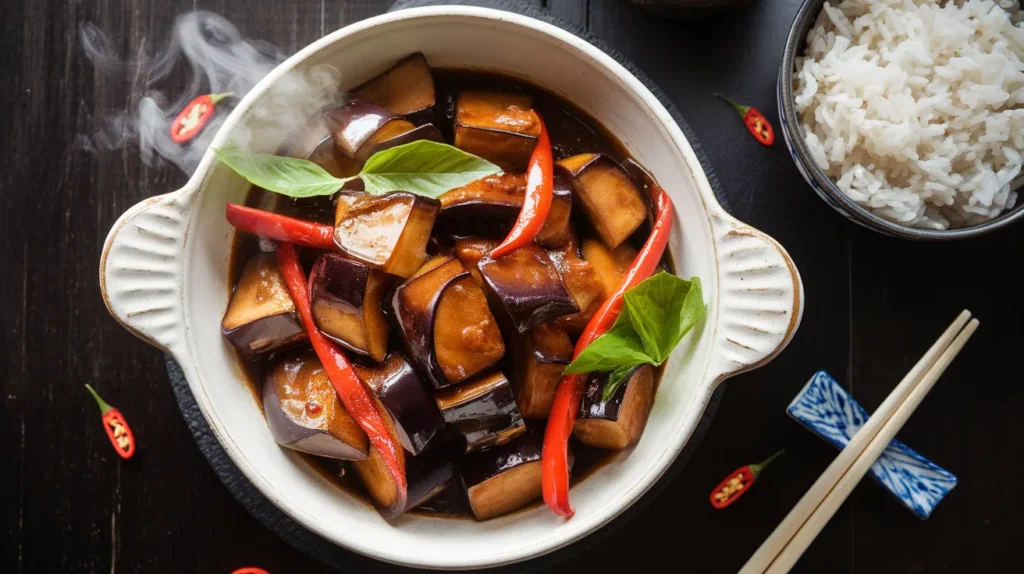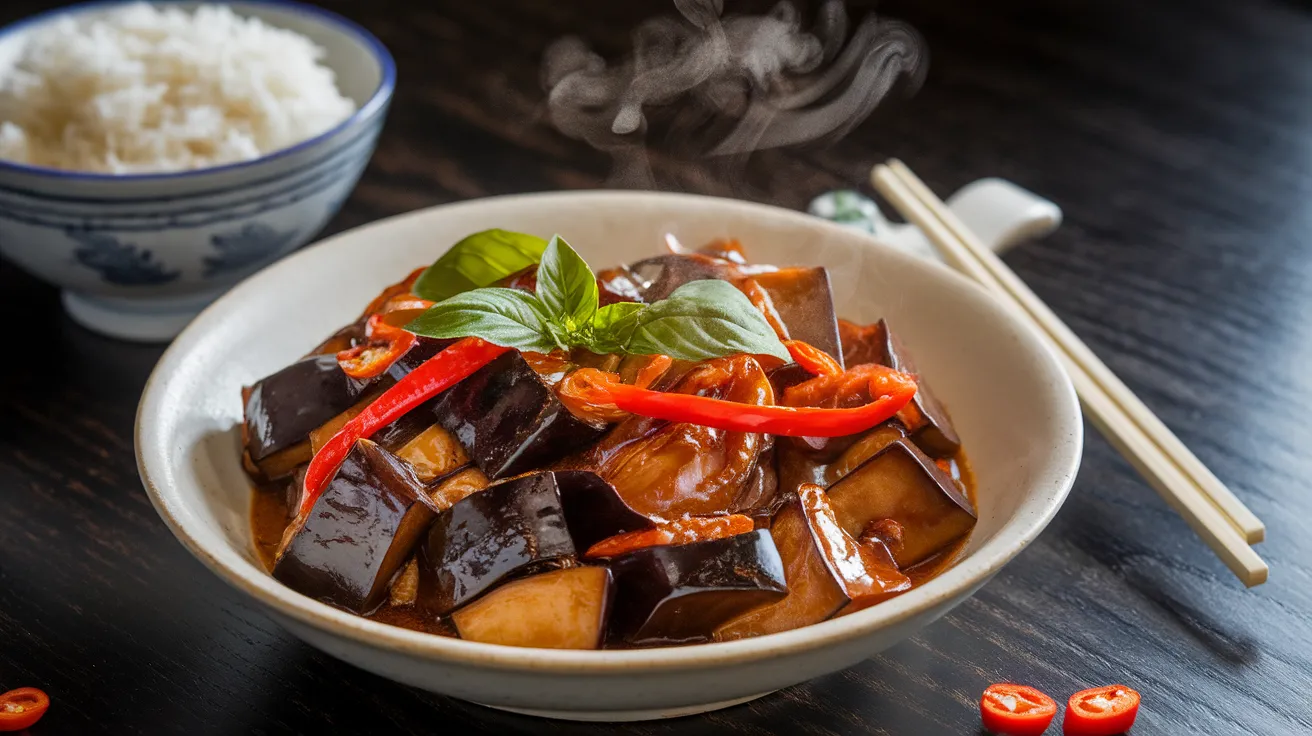This vibrant spicy Thai eggplant recipe brings authentic Southeast Asian flavors straight to your kitchen. Tender Japanese eggplant pieces swim in a glossy, aromatic sauce that balances sweet, salty, and fiery elements perfectly. This spicy Thai eggplant dish transforms humble vegetables into an addictive main course that pairs beautifully with steamed jasmine rice.
SERVES: 4 | PREP: 15 MIN | COOK: 12 MIN | TOTAL: 27 MIN
Ingredients for Spicy Thai Eggplant
Vegetables
| Ingredient | Amount |
|---|---|
| Japanese eggplant | 2 lbs (about 4 medium) |
| Red bell pepper | 1 large |
| Thai bird’s eye chilies | 3-5 pieces |
| Garlic cloves | 6 pieces |
| Fresh ginger | 2-inch piece |
| Green onions | 4 stalks |
Sauce Base
| Ingredient | Amount |
|---|---|
| Soy sauce | 3 tablespoons |
| Fish sauce | 2 tablespoons |
| Brown sugar | 2 tablespoons |
| Rice vinegar | 1 tablespoon |
| Sesame oil | 1 teaspoon |
Cooking Elements
| Ingredient | Amount |
|---|---|
| Vegetable oil | 1/4 cup |
| Thai basil leaves | 1/2 cup |
| Cornstarch | 1 tablespoon |
| Water | 2 tablespoons |
Step-by-Step Spicy Thai Eggplant Instructions
Phase 1: Preparation (8 minutes)
Step 1: Cut eggplant into 2-inch cubes, leaving skin on for texture. The skin helps hold the pieces together during cooking and adds beautiful color contrast.
Step 2: Place cut eggplant in a large bowl and toss with 1 teaspoon salt. Let sit for 5 minutes to draw out bitter compounds. This crucial step prevents that unpleasant astringent taste some people associate with eggplant.
Step 3: While eggplant rests, mince garlic and ginger together until they form a fragrant paste. The oils from both will infuse better when chopped fine.
Step 4: Slice Thai chilies thin (wear gloves!). Remove seeds for milder heat, or keep them for authentic fire. Start with 2 chilies if you’re heat-sensitive.
Step 5: Cut red bell pepper into strips matching your eggplant size. Uniform pieces ensure even cooking throughout your spicy Thai eggplant dish.
Phase 2: Sauce Creation (3 minutes)
Step 6: Whisk together soy sauce, fish sauce, brown sugar, and rice vinegar in a small bowl. Taste and adjust – it should be slightly salty-sweet since it’ll dilute when cooking.
Step 7: Mix cornstarch with 2 tablespoons water to create slurry. This will thicken your sauce to coat each piece of eggplant beautifully.
Phase 3: High-Heat Cooking (12 minutes)
Step 8: Heat wok or large skillet over high heat until smoking. Add vegetable oil and swirl to coat. The oil should shimmer and move freely – this indicates proper temperature.
Step 9: Pat eggplant dry with paper towels (crucial step!). Add to hot oil in single layer. Don’t overcrowd or steam will prevent browning.
Step 10: Let eggplant sear undisturbed for 3 minutes until golden-brown on bottom. Resist the urge to stir – good browning creates complex flavors.
Step 11: Flip eggplant pieces and cook another 2 minutes. They should feel tender when pierced with fork but still hold their shape.
Step 12: Push eggplant to one side of pan. Add garlic-ginger paste to empty space and fry for 30 seconds until fragrant. This technique prevents burning the aromatics.
Step 13: Add sliced chilies and bell pepper. Stir everything together and cook 2 minutes until peppers are crisp-tender.
Step 14: Pour sauce mixture over vegetables and toss quickly. The sauce should sizzle and start thickening immediately.
Step 15: Add cornstarch slurry and stir constantly for 1 minute until sauce becomes glossy and coats everything evenly.
Step 16: Remove from heat and stir in Thai basil leaves and sesame oil. The basil will wilt slightly but maintain its bright color.
Step 17: Garnish with sliced green onions and serve immediately over steamed rice.
Chef’s Notes
Heat Control: Start with fewer chilies and add more next time if desired. You can always increase spice, but you can’t take it back once it’s in your spicy Thai eggplant.
Eggplant Selection: Japanese eggplant works best because it has fewer seeds and more tender flesh. Chinese eggplant is a good substitute if Japanese isn’t available.
Oil Temperature: Proper oil temperature prevents soggy eggplant. If the oil isn’t hot enough, the eggplant will absorb too much oil and become greasy.
Basil Timing: Add Thai basil at the very end to preserve its bright, anise-like flavor that makes this dish authentically Thai.
Nutrition Information (Per Serving)
- Calories: 185
- Protein: 4g
- Carbohydrates: 22g
- Fat: 11g
- Fiber: 8g
- Sodium: 890mg
Delicious Variations
Protein-Packed Version: Add 1 lb sliced chicken thighs or firm tofu in step 9, cooking until golden before adding eggplant.
Vegetarian Alternative: Replace fish sauce with extra soy sauce plus 1 teaspoon mushroom sauce for deeper umami flavor.
Milder Family Style: Use bell peppers instead of Thai chilies and add just a pinch of red pepper flakes for gentle heat everyone can enjoy.
Smoky Twist: Try this smoked eggplant technique first, then follow the recipe for incredible depth of flavor, or explore our stir-fried eggplants with basil for another Thai-inspired option.
Storage & Reheating Guide
Refrigerator: Store leftover spicy Thai eggplant in airtight container for up to 3 days. The flavors actually improve overnight as they meld together.
Freezing: This dish doesn’t freeze well due to eggplant’s high water content, which becomes mushy when thawed.
Reheating: Warm in skillet over medium heat, adding 1-2 tablespoons water to loosen sauce. Microwave reheating makes eggplant soggy.
Make-Ahead Tip: Prep all vegetables and mix sauce up to 1 day ahead. Store separately and combine during cooking for best results.

Troubleshooting Common Issues
Problem: Eggplant turned mushy and broken apart. Solution: Cut larger pieces next time and don’t skip the salting step. Also ensure oil is properly heated before adding eggplant.
Problem: Dish tastes too salty or too sweet. Solution: Balance with rice vinegar (for saltiness) or a pinch more brown sugar (for oversalted dishes). Taste sauce before adding to pan.
Problem: Sauce won’t thicken properly. Solution: Make fresh cornstarch slurry – old slurry loses thickening power. Cook sauce longer while stirring to activate cornstarch.
Problem: Eggplant absorbed too much oil and tastes greasy. Solution: Oil wasn’t hot enough initially. Next time, ensure oil shimmers before adding vegetables and pat eggplant completely dry.
Problem: Not spicy enough despite using recommended chilies. Solution: Thai chilies vary in heat. Add chili oil or sriracha at the end, or include chili seeds which contain most of the capsaicin.
Equipment Essentials
- Large wok or heavy-bottomed skillet (12-inch minimum)
- Sharp chef’s knife for clean vegetable cuts
- Cutting board (preferably separate one for aromatics)
- Small whisk for sauce mixing
- Paper towels for drying eggplant
- Heat-resistant spatula for high-temperature stirring
Shopping List by Store Section
Produce Department
- Japanese eggplant (2 lbs)
- Red bell pepper (1 large)
- Thai bird’s eye chilies (1 small container)
- Fresh ginger (2-inch piece)
- Garlic (1 head)
- Green onions (1 bunch)
- Thai basil (1 package)
Asian Condiment Aisle
- Soy sauce
- Fish sauce
- Rice vinegar
- Sesame oil
Baking Aisle
- Brown sugar
- Cornstarch
Oil Section
- Vegetable oil for cooking
Success Secrets for Perfect Spicy Thai Eggplant
- Salt the eggplant first – This removes bitterness and prevents the vegetable from absorbing excessive oil during cooking.
- Use the highest heat possible – Thai stir-fries require intense heat for proper texture and that characteristic “wok hei” flavor.
- Don’t overcrowd the pan – Cook in batches if necessary to maintain high temperature and achieve proper browning.
- Prep everything before cooking – Once you start stir-frying, there’s no time to chop ingredients. Have everything ready.
- Taste and adjust at the end – Every batch of chilies and fish sauce varies in intensity, so always taste your spicy Thai eggplant before serving and adjust seasoning as needed.




